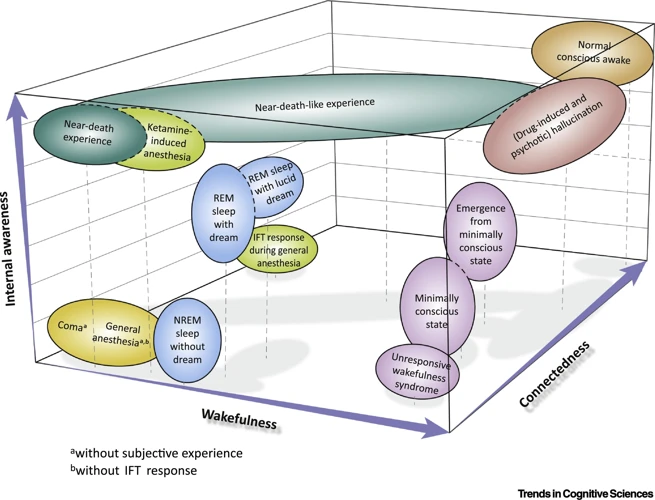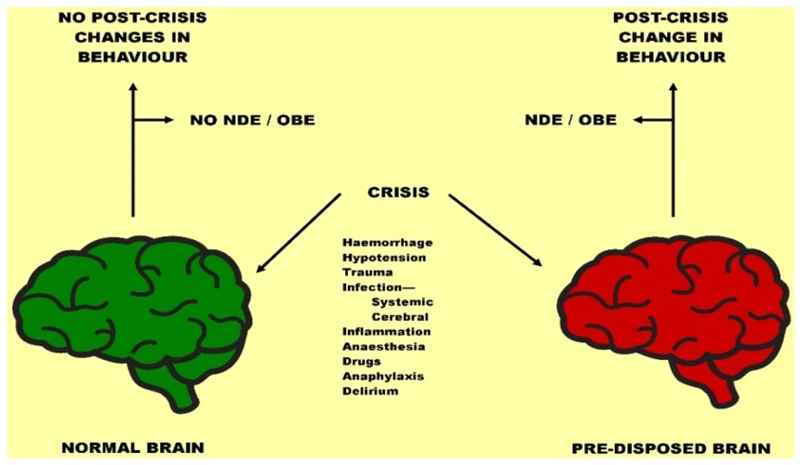Human beings have been baffled by the notion of death since the beginning of time. A part of this mystery surrounds the concept of near-death experiences (NDEs), where individuals who are at the brink of death report a variety of strange and often spiritual experiences. While NDEs have been studied for quite some time, the phenomenon still raises many questions. How are these experiences happening? Is there a scientific explanation? What does it mean for our understanding of consciousness and the afterlife? In this article, we will delve into the neuroscience behind near-death experiences and explore what the latest research has to say.
Understanding Near-Death Experiences

When we talk about near-death experiences, many people’s thoughts will immediately turn towards the idea of an afterlife, a place beyond our physical existence where our consciousness lives on. However, before we delve into the spiritual significance of these experiences, we must first develop an understanding of what they are and what these experiences entail. Near-death experiences (NDEs) are a murky area of study, surrounded in controversy and shrouded in misunderstanding. Though these experiences have been recorded across cultures, they are not fully understood by modern neuroscience. Despite this, researchers are committed to studying what happens in the brain when someone has an NDE. In this section, we will explore the common themes and features of these experiences, setting a foundation for further discussion.
What are Near-Death Experiences?
Near-Death Experiences (NDEs) are a powerful and often transformative experience that occurs when a person is on the brink of death or has been declared clinically dead. During an NDE, the person may experience a range of sensations, including a sense of detachment from the body, a feeling of immense peace and well-being, and encounters with deceased loved ones or spiritual beings.
Common experiences during a near-death experience may include:
- A sense of leaving the body or being out of the physical body
- Seeing a bright light or tunnel
- Encountering deceased loved ones or spiritual beings
- Feeling a sense of peace or joy
- Having a life review
- Experiencing a sense of timelessness
- Feeling an overwhelming sense of love or unity with others
NDEs are often described as a profound and life-changing experience. Many people report that their NDE gave them a deeper understanding of the purpose of life and the nature of reality. However, the scientific community has long been skeptical of NDEs, and until recently, there was little research on the subject.
Recent studies have shed new light on the subject, and there is now growing evidence to suggest that NDEs may have a basis in neuroscience. While the exact mechanisms behind NDEs are still not fully understood, researchers believe that they may be the result of changes in the brain’s chemistry and electrical activity as the body undergoes the process of dying.
Common Themes in Near-Death Experiences
When examining the stories of individuals who have experienced near-death experiences, several common themes emerge. These themes provide insight into the nature of these experiences and their potential significance. Here are some of the most common themes:
- Out-of-body experiences: Many individuals report feeling as if they have left their physical bodies and are observing the world from a different vantage point. Some have even reported watching medical professionals attempt to revive them.
- Intense emotions: Near-death experiences are often described as being incredibly emotional. Many individuals report feelings of overwhelming love, peace, and joy during their experience.
- Tunnel or vortex: Many individuals describe traveling through a tunnel or vortex as they approach death. This tunnel is often described as being dark or enveloped in light.
- Encountering deceased loved ones: Some individuals report seeing deceased loved ones or pets during their near-death experience. These encounters are often described as being brief but incredibly meaningful.
- Life review: Many people who claim to have had near-death experiences describe watching a review of their life. They may see significant events from their past and encounter individuals with whom they have had relationships.
- Encountering a being of light: Some individuals report encountering a being of light or a divine figure during their near-death experience. This being may provide individuals with guidance, support, or a sense of purpose.
These common themes suggest that near-death experiences are often deeply spiritual and meaningful events that can have a profound impact on individuals who experience them. Understanding these themes can help researchers and medical professionals better understand and support patients who have undergone a near-death experience.
The Science of Near-Death Experiences

As we delve deeper into the phenomenon of near-death experiences, it’s impossible not to wonder about the scientific explanations behind them. Through the years, many researchers and scientists have attempted to explore the neurological and physiological aspects of this phenomenon. From exploring the chemical changes in the brain to investigating the impact of oxygen deprivation on consciousness, the scientific community has contributed a great deal of knowledge to our understanding of near-death experiences. Additionally, these findings have sparked debates about the implications of these experiences on our understanding of life, death, and the nature of consciousness itself. Let’s dive into the scientific theories surrounding near-death experiences and what it means for us as humans.
Neurological Explanations for Near-Death Experiences
One of the main theories attempting to explain Near-Death Experiences (NDEs) is rooted in neurology. Here are some of the possible neurological explanations behind NDEs:
- Decreased oxygen to the brain: Lack of oxygen to the brain, also known as cerebral hypoxia, can lead to a range of physical sensations, including feelings of euphoria, dizziness, and even out-of-body experiences. The brain, upon experiencing decreased oxygen levels, tries to conserve its remaining resources and triggers a cascade of neurotransmitters and other chemicals that can induce hallucinations.
- Release of endorphins: In a stressful situation, the body releases endorphins to help it cope. Endorphins act as a natural painkiller and can induce feelings of euphoria and relaxation. It is possible that the release of these endorphins during a life-threatening situation like an NDE could account for some of the positive emotions reported by NDE survivors.
- Activation of the limbic system: The limbic system is the part of the brain involved in regulating emotions, memory, and various autonomic functions. During an NDE, it is believed that the limbic system is activated, leading to feelings of peace and transcendence. Additionally, the amygdala, a part of the limbic system responsible for processing emotions, may also play a role in NDEs.
- Electrical stimulation of the brain: Researchers have been able to induce experiences similar to NDEs through electrical stimulation of certain parts of the brain, including the temporal lobe. This suggests that altered brain activity can account for some of the experiences reported by NDE survivors.
- Hallucinations caused by medication: NDE-like experiences can also be caused by certain medications, such as ketamine or LSD, which can induce hallucinations and alter one’s perception of reality. It is possible that some NDE survivors were under the influence of such medication during their NDE.
While these neurological explanations provide a potential framework for understanding NDEs, they do not account for the spiritual significance that many people attribute to these experiences.
Research and Findings
Over the years, there have been numerous studies conducted on the science behind near-death experiences. Here are some of the most significant research findings:
- Increased brain activity: One research study published in 2013 found that when rats were subjected to cardiac arrest, there was a surge of electrical activity in their brains moments before their hearts stopped beating. This finding supports the idea that near-death experiences may be a result of heightened brain activity, rather than a lack of brain function.
- Altered states of consciousness: A study from the University of Michigan found that those who reported near-death experiences showed elevated levels of carbon dioxide, which can cause hallucinations and altered states of consciousness.
- Similar experiences across cultures: Another study found that despite cultural differences, people from all over the world reported similar experiences during near-death experiences, including feeling a sense of peace and seeing a bright light.
- Potential for positive impact: Some research suggests that having a near-death experience can have positive effects on a person’s mental health, including a decreased fear of death and an increased appreciation for life.
The science behind near-death experiences is complex and multifaceted. While some findings support neurological explanations for these experiences, others suggest that there may be deeper spiritual implications. Ultimately, the significance and meaning of near-death experiences may vary from person to person.
The Spiritual Significance of Near-Death Experiences
As we delve deeper into the world of near-death experiences (NDEs), we find that many individuals have reported heightened spiritual awareness and a newfound appreciation for life. These experiences often leave individuals with a sense of perplexity as they struggle to reconcile their beliefs with what they have witnessed. The impact of NDEs on personal beliefs and their potential implications for understanding consciousness and the afterlife cannot be ignored. Let’s explore the spiritual significance of NDEs and the profound effects they can have on those who experience them.
Impact on Personal Beliefs
The impact of near-death experiences (NDEs) on personal beliefs cannot be denied. For many individuals who have gone through such an experience, it has changed the way they view life and death. The following are some of the ways in which NDEs have impacted personal beliefs.
- Belief in an afterlife: NDEs often involve experiences of seeing a bright light or feeling a strong sense of peace and love. These experiences are commonly interpreted as evidence of an afterlife or a higher power. As a result, many who have had an NDE develop a strong belief in an afterlife.
- Belief in a higher power: While some individuals attribute their NDEs to physiological or psychological explanations, many others view it as a supernatural or divine experience. This can lead to a belief in a higher power or divine entity.
- Reduced fear of death: NDEs often involve a sense of peace and acceptance, which can lead to a reduced fear of death. Many individuals who have had an NDE report feeling less anxious about the prospect of dying.
- Increased appreciation for life: The profound and transformative nature of NDEs can lead individuals to feel a renewed appreciation for life. They may feel a greater sense of purpose and a desire to live their lives to the fullest.
- Expanded understanding of reality: NDEs often involve experiences that challenge one’s previous understanding of reality. This can lead to a broader perspective on life and an openness to new ideas and beliefs.
Near-death experiences can have a profound impact on personal beliefs. They can lead to a belief in an afterlife or a higher power, reduced fear of death, an increased appreciation for life, and an expanded understanding of reality.
Implications for Understanding Consciousness and the Afterlife
Near-death experiences have been at the forefront of philosophical and religious debates for years. The implications of near-death experiences are significant for understanding consciousness and the afterlife. The fact that these experiences are similar across cultures and beliefs and are often accompanied by a sense of peacefulness and transcendence suggests that there may indeed be an afterlife.
Interestingly, some researchers in neuroscience argue that these experiences can be explained solely by brain activity, while others believe that they hold a more profound meaning. Regardless of the differing opinions, these experiences provide a compelling basis for questioning the nature of consciousness and life after death.
One of the most significant implications of near-death experiences is the idea that consciousness may exist beyond the physical body. If the brain is solely responsible for consciousness, then these experiences should cease once the brain ceases to function. However, if consciousness exists beyond the physical body, then these experiences may provide evidence supporting the idea that the soul or consciousness can survive death.
Near-death experiences suggest that consciousness may be non-local, or not necessarily confined to the brain. The fact that some near-death experiencers report seeing events or objects at a distant location while unconscious raises fascinating questions about the nature of consciousness and its relationship with time and space.
Near-death experiences represent a fundamental challenge to the materialistic view of the universe, which suggests that consciousness arises only from physical matter. Instead, these experiences suggest that there may be more to the universe – and to ourselves – than we currently understand. The implications of near-death experiences are far-reaching and provide a launchpad for philosophical, religious, and scientific inquiry into the nature of consciousness and the afterlife.
| Implications of Near-Death Experiences | Explanation |
| The possibility of an afterlife | Near-death experiences suggest that there may be an afterlife due to the similarities in experiences across cultures and religions. |
| The concept of consciousness beyond the physical body | If near-death experiences are beyond the control of the physical body, it lends support to the idea of consciousness beyond the physical body. |
| Non-local consciousness | Reports of seeing events or objects from a distance while unconscious suggest that consciousness might exist beyond the physical body. |
| Challenging materialistic view of the universe | Near-death experiences challenge the idea that consciousness is purely a product of physical matter such as the brain. |
Conclusion
In conclusion, the neuroscience behind near-death experiences has shed light on the phenomenon and challenged traditional beliefs about the afterlife. While there is still much to learn about the complex and mysterious workings of the human brain, the scientific explanations for near-death experiences provide a plausible and logical framework for understanding the subjective experiences reported by individuals.
However, it is important to note that the spiritual significance of near-death experiences cannot be dismissed or overlooked. For many individuals, these experiences have had a profound impact on their personal beliefs and understanding of life after death. Further research and dialogue between science and spirituality is needed to fully understand the implications of near-death experiences for our understanding of consciousness and the afterlife.
Overall, the study of near-death experiences offers a unique opportunity for exploring the intersection of science and spirituality. By exploring both the neurological and spiritual aspects of near-death experiences, we can gain a deeper understanding of the human experience and the mysteries of death and beyond.
Frequently Asked Questions
1. How common are near-death experiences?
Estimates suggest that as many as 4% of the world’s population has experienced a near-death experience.
2. Do all near-death experiences involve spiritual or religious elements?
No, some near-death experiences do not involve spiritual or religious experiences.
3. Can near-death experiences be explained by physiological factors alone?
While some aspects of near-death experiences can be explained by physiological factors, other aspects remain unexplained by current scientific understanding.
4. Can people who have not died have a near-death experience?
Yes, a near-death experience can occur in situations where a person feels that they are in danger of imminent death, even if death does not ultimately occur.
5. Are near-death experiences always positive?
No, while many near-death experiences are positive, some can be negative, distressing, or confusing.
6. Do embattled visions suggests that near-death experiences are not real?
No, embattled visions do not necessarily suggest that near-death experiences are not real. It is possible that they are subjective experiences that are shaped by individual beliefs and expectations.
7. Can near-death experiences change a person’s fundamental beliefs?
Yes, near-death experiences can sometimes be a transformative experience, leading to changes in beliefs and values.
8. Is it possible to simulate a near-death experience?
Yes, some studies have used drugs, sensory deprivation, and other techniques to simulate aspects of a near-death experience in a controlled setting.
9. Are near-death experiences culturally universal?
No, the specific details and interpretations of a near-death experience can be influenced by individual beliefs and cultural background.
10. Can near-death experiences provide evidence for the existence of an afterlife?
While some people believe that near-death experiences provide evidence for the existence of an afterlife, there currently is no scientific evidence to support this assertion.








